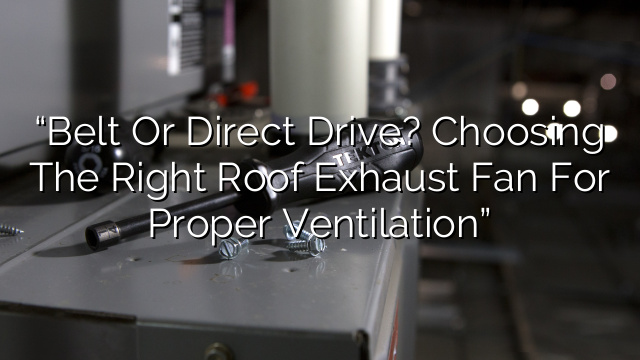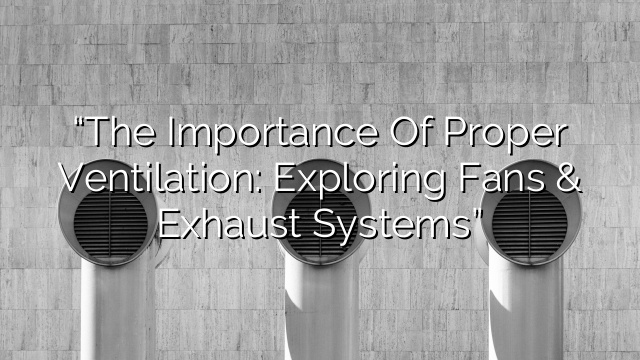Fans & Ventilation: Roof Exhaust Fans
When it comes to proper ventilation in industrial and manufacturing facilities, roof exhaust fans are a crucial component. They help remove stale air, fumes, and odors, ensuring a healthy and comfortable working environment. However, choosing the right type of roof exhaust fan can be a daunting task. One of the most important decisions to make is whether to opt for a belt or direct drive system. In this article, we will examine the differences between these two drive types and guide you in choosing the right roof exhaust fan for your specific needs.
Belt Drive Exhaust Fans
1. Design and Functionality
Belt drive exhaust fans are designed with a motor and a pulley system connected by a belt. The motor sits away from the fan blades, and the belt drive system allows for adjustable fan speeds by changing the pulley size.
- Low fan speed options available
- Noise reduction due to the distance between the motor and fan blades
- Longer belt life due to reduced strain on the motor
2. Advantages
- Versatility: Belt drive fans are suitable for a wide range of applications due to their adjustable fan speeds.
- Higher static pressure: Belt drive fans are ideal for situations where high static pressure is required, such as situations where ductwork resistance is significant.
3. Disadvantages
- Maintenance: Belt drive systems require periodic maintenance, including belt replacement and adjustment.
- Higher operating costs: Belt drive fans consume more energy compared to direct drive fans due to the energy lost in the belt and pulley system.
- Noisier operation: While the belt drive system reduces noise transmission from the motor, the belt itself can generate additional noise and require regular inspection for wear and tear.
Direct Drive Exhaust Fans
1. Design and Functionality
Direct drive exhaust fans have a motor directly connected to the fan impeller on the same shaft. This configuration eliminates the need for a belt and pulley system.
- Simple design with fewer moving parts
- Generally lower maintenance requirements
- More compact and lightweight
2. Advantages
- Energy efficient: Direct drive fans have higher energy efficiency compared to belt drive fans due to the absence of energy loss in the belt and pulley system.
- Quieter operation: Direct drive fans produce less noise compared to belt drive fans because there are no additional noise sources like belts and pulleys.
- Lower operating costs: The improved energy efficiency of direct drive fans leads to lower operating costs over time.
3. Disadvantages
- Limited fan speed options: Direct drive fans operate at fixed fan speeds, which may not accommodate all ventilation requirements.
- Lower static pressure: Direct drive fans may struggle with high static pressure situations where duct resistance is significant.
Belt or Direct Drive: Which One Should You Choose?
Now that we have examined the characteristics of both belt drive and direct drive exhaust fans, let’s explore some factors to consider when making your decision:
- Noise: If noise reduction is your top priority, belt drive fans may be a better option as they often offer quieter operation.
- Energy Efficiency: For long-term energy savings, direct drive fans are recommended. They are generally more energy efficient due to the absence of energy loss in the belt and pulley system.
- Fan Speed Control: If adjustable fan speeds are required for your specific application, belt drive fans are the way to go. They allow for more flexibility in controlling airflow rates.
- Static Pressure: If you anticipate significant static pressure in your ventilation system (e.g., due to long duct runs), belt drive fans are better equipped to handle the resistance.
- Maintenance: If you prefer a fan system with lower maintenance requirements, direct drive fans are a suitable choice. They have fewer moving parts and generally require less attention.
In conclusion, the decision to choose between a belt drive and direct drive roof exhaust fan ultimately depends on your specific needs and priorities. Consider factors such as noise, energy efficiency, fan speed control, static pressure, and maintenance requirements. Consulting with a ventilation expert can also provide valuable insights and guidance tailored to your facility.
Frequently Asked Questions
Q: Are belt drive fans more expensive than direct drive fans?
A: The cost of a fan is determined by various factors, including its size, materials, and specifications. While belt drive fans may require more upfront investment due to their adjustable speed features, it’s essential to consider long-term operating costs, including energy consumption and maintenance requirements.
Q: How often should I replace the belts on a belt drive exhaust fan?
A: Belt replacement intervals vary depending on factors such as fan usage, operating conditions, and the type of belt used. As a general guideline, it is recommended to visually inspect the belts regularly for signs of wear and replace them if any significant wear or cracks are observed. It’s also advised to follow the manufacturer’s recommendations for belt replacement to ensure optimal fan performance.
Q: Can I convert a belt drive fan to a direct drive fan or vice versa?
A: Converting a fan between belt drive and direct drive configurations can be challenging and may require replacing the motor, fan blade, and other components. It is recommended to consult with a ventilation specialist or the fan manufacturer to determine the feasibility and cost-effectiveness of such a conversion for your specific fan model.
Q: Do all belt drive fans offer adjustable fan speeds?
A: While most belt drive fans offer adjustable fan speeds, it is crucial to check the specific model’s specifications to ensure it meets your requirements. Fan speed control may be achieved through pulley adjustments, variable frequency drives (VFDs), or other mechanisms, depending on the fan design.
Q: Can a direct drive fan handle high temperatures in an industrial setting?
A: The ability of a direct drive fan to handle high temperatures depends on its motor and construction materials. It is essential to select a direct drive fan designed explicitly for high-temperature environments, with motors and components capable of withstanding the anticipated temperatures.
Q: What maintenance is required for direct drive fans?
A: While direct drive fans generally have lower maintenance requirements compared to belt drive fans, it is still necessary to regularly inspect and clean the fan blades, motor housing, and electrical components. Regular lubrication of motor bearings and periodic motor maintenance may also be necessary, depending on the fan’s usage and operating conditions.














